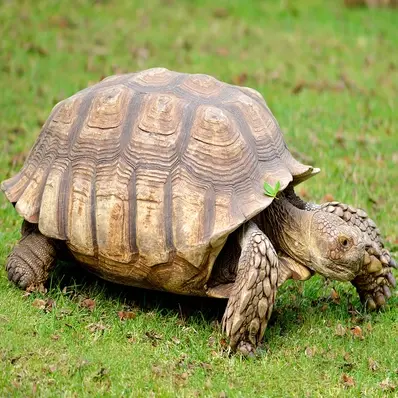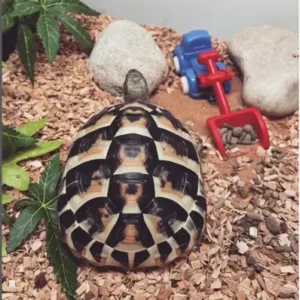History/Origin
The African Spurred Tortoise, also known as the Sulcata Tortoise, comes from the dry areas of sub-Saharan Africa. It’s part of the Testudinidae family, with a really long history of evolution.
This tortoise has adapted well to tough conditions, surviving for a long time with its strong and tough nature. Its shell protects it from the hot African sun, and over time, it has developed smart ways to survive.
People admire this tortoise for its ability to live in challenging places, showing how reptiles like it can adapt to the tough African environment.
Personality
Known for their gentle and sociable nature, African-spurred tortoises make for docile companions. They are generally calm and enjoy basking in the sun. While not as interactive as some pets, they exhibit a distinct personality, often showcasing curiosity and adaptability.
Physical Appearance
Let’s examine the physical characteristics of the African Spurred Tortoise.
- Size: Adult African Spurred Tortoises typically reach a size of 30 inches in length, with some tortoises growing even larger.
- Color: Their shell, or carapace, is characterized by a blend of earthy tones, including shades of brown and yellow. The patterns on their shells can be intricate and unique, adding to their aesthetic appeal.
Gender Differences
Distinguishing between male and female African-spurred tortoises requires careful observation, as the differences are subtle.
- Males are typically larger and more robust compared to females.
- Males have longer tails extending beyond their shells, while females have shorter tails.
- The undershell, known as the plastron, differs between genders: males usually have a curved plastron for stability during mating, while females have a flatter plastron for a smoother surface.
- Individual variations exist, so seeking expert assistance can help in accurate gender identification.
Feed/Nutrition
So what do African spurred tortoise eat? Take a look at the dietary preferences and nutritional needs of these reptiles here and find out.
Dietary Composition:
- Grasses and Hay: High-fiber grasses and hay aid digestion and provide roughage.
- Leafy Greens: Dark, leafy greens like kale and collard greens offer vitamins and minerals.
- Vegetables: Provide variety with carrots, bell peppers, and squash for comprehensive nutrition.
- Calcium Supplementation: Offer cuttlebone or calcium powder supplemented by calcium-rich vegetables. It is vital for strong shell development; and prevents metabolic bone disease.
Nutritional Considerations:
- Balancing Nutrient Ratios: Maintain a proper calcium-to-phosphorus ratio for optimal shell health.
- Hydration: Ensure access to fresh water; occasional soaks prevent dehydration.
Cautionary Notes
- Avoid High-Protein Diets: Limit high-protein foods to prevent health issues.
- Moderation is Key: Offer food in moderation to prevent obesity; adjust portions based on weight.
Health
Like many reptiles, African spurred tortoises are susceptible to certain health issues.
Below are some of these concerns:
- Pyramiding
Pyramiding refers to the abnormal upward growth of scutes on the tortoise’s shell. Inadequate diet, insufficient humidity, or improper UVB lighting can contribute to this condition. Providing a balanced diet, maintaining proper humidity levels, and ensuring access to UVB light helps prevent pyramiding.
- Bacterial or Fungal Infections
Infections may manifest as lesions, discoloration, or swelling on the shell or skin. Poor hygiene, unclean living conditions, or injuries can lead to bacterial or fungal infections. Prompt veterinary intervention is crucial. Antibiotics or antifungal medications may be prescribed.
- Dehydration
Insufficient water intake can result in dehydration. Inadequate water availability, especially in arid environments. Ensure a constant supply of fresh water, and monitor hydration levels, especially in warmer climates.
- Respiratory Issues
Respiratory problems may manifest as audible breathing issues or nasal discharge. Incorrect humidity levels, exposure to drafts, or respiratory infections. Seek veterinary advice; adjustments in humidity and temperature may be recommended.
- Metabolic Bone Disease (MBD)
MBD results from calcium or vitamin D3 deficiencies, leading to weakened bones. Imbalanced diet, lack of UVB exposure, or inadequate calcium supplementation. Provide a diet rich in calcium, offer UVB lighting, and ensure proper supplementation.
- Parasitic Infestations
Worms, mites, or ticks can infest the tortoise. Contaminated food, exposure to infected animals, or unclean living conditions. Veterinary diagnosis is crucial for accurate identification and treatment.
- Egg-Laying Complications (Females)
Female tortoises may encounter difficulties laying eggs. Inadequate nesting conditions, lack of privacy, or improper diet. Provide suitable nesting sites and ensure a well-balanced diet.
Overgrown Beak and Nails
Overgrown beaks and nails can impede normal activities. Insufficient opportunities for natural wear or a diet lacking in proper abrasion. Regular trimming may be necessary, performed by a veterinarian with experience in reptile care.
Care and Grooming
Ensuring optimal care for African Spurred Tortoises involves creating a spacious and secure enclosure, complete with a warm basking area to mimic their natural habitat. Regular inspections for shell abnormalities are important for early detection and intervention.
Grooming entails careful habitat cleanliness to prevent bacterial or fungal issues. Additionally, access to fresh water is paramount for hydration. These careful practices help ensure the long and healthy lives of these fascinating reptiles when housed indoors.
Rescue Groups
Various reptile rescue organizations and animal shelters may have African Spurred Tortoises available for adoption. These groups specialize in providing homes for displaced or surrendered tortoises.
Species for Sale
Here are some reputable breeders and exotic pet stores that offer African-spurred tortoises for sale.
Interesting Facts
- African Spurred Tortoises are expert diggers, creating burrows to escape extreme temperatures.
- Despite their slow pace, these tortoises can reach surprising speeds when motivated.
- The impressive size of their front limbs helps them navigate and dig efficiently.
- African Spurred Tortoises have a unique, resonant vocalization often described as a “hissing” sound.
- In the wild, these tortoises are known to migrate considerable distances in search of food and water.
Best For
African Spurred Tortoises are best suited as pets for reptile enthusiasts who have the space, commitment, and appreciation for caring for a unique, long-lived species. They thrive in environments where individuals are more inclined towards observing and maintaining these fascinating tortoises. Their suitability lies in homes where caregivers can provide the necessary space, proper husbandry, and a fulfilling environment to ensure the well-being of these reptiles.
Top Names
| Male African Spurred Tortoise Names | Female African Spurred Tortoise Names |
| Titan | Terra |
| Rocky | Ivy |
| Spike | Bella |
| Atlas | Daisy |
| Tank | Luna |










